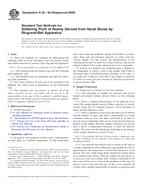We need your consent to use the individual data so that you can see information about your interests, among other things. Click "OK" to give your consent.
ASTM E28-99(2009)
Standard Test Methods for Softening Point of Resins Derived from Naval Stores by Ring-and-Ball Apparatus
STANDARD published on 1.6.2009
The information about the standard:
Designation standards: ASTM E28-99(2009)
Note: WITHDRAWN
Publication date standards: 1.6.2009
SKU: NS-46055
The number of pages: 6
Approximate weight : 18 g (0.04 lbs)
Country: American technical standard
Category: Technical standards ASTM
Annotation of standard text ASTM E28-99(2009) :
Keywords:
ring and ball, rosin, softening point, Resins, Ring-and-ball apparatus, Rosin, Softening point, ICS Number Code 87.060.20 (Binders)
Additional information
| Significance and Use | ||||||||
|
In general, with materials of these types, softening does not take place at a definite temperature. As the temperature rises, these materials gradually change from brittle or exceedingly thick and slow-flowing materials to softer and less viscous liquids. For this reason, the determination of the softening point must be made by a fixed, arbitrary, and closely defined method if the results obtained are to be comparable. In these test methods, the softening point is defined as the temperature at which a disk of the sample held within a horizontal ring is forced downward a distance of 25.4 mm (1 in.) under the weight of a steel ball as the sample is heated at 5°C/min in a water, glycerin, silicone oil, ethylene glycol/water or glycerin/water bath. |
||||||||
| 1. Scope | ||||||||
|
1.1 These test methods are intended for determining the softening point of resins (including rosin and terpene resins) and similar materials by means of the ring-and-ball apparatus. Note 1—For testing asphalts, tars, and pitches, see Test Method D 36. 1.1.1 Test method using the manual ring and ball softening point apparatus, and 1.1.2 Test method using an automated ring and ball softening point apparatus. 1.2 The values stated in SI units are to be regarded as the standard. The values given in parentheses are for information only. 1.3 This standard does not purport to address all of the safety concerns, if any, associated with its use. It is the responsibility of the user of this standard to establish appropriate safety and health practices and determine the applicability of regulatory limitations prior to use. |
||||||||
| 2. Referenced Documents | ||||||||
|
We recommend:
Technical standards updating
Do you want to make sure you use only the valid technical standards?
We can offer you a solution which will provide you a monthly overview concerning the updating of standards which you use.
Would you like to know more? Look at this page.




 Cookies
Cookies
